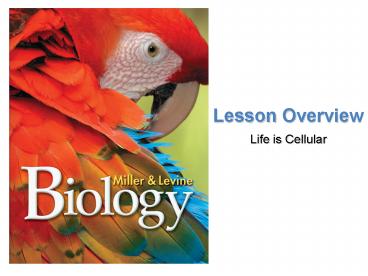Lesson Overview - PowerPoint PPT Presentation
1 / 32
Title:
Lesson Overview
Description:
Lesson Overview Life is Cellular Lesson Overview Life Is Cellular THINK ABOUT IT What s the smallest part of any living thing that still counts as being alive? – PowerPoint PPT presentation
Number of Views:389
Avg rating:3.0/5.0
Title: Lesson Overview
1
Lesson Overview
- Life is Cellular
2
THINK ABOUT IT
- Whats the smallest part of any living thing
that still counts as being alive? - Can we just keep dividing living things into
smaller and smaller parts, or is there a point at
which whats left is no longer alive?
3
Early Microscopes
- Mid-1600s scientists began using compound
microscopes to observe living things. - In 1665, Robert Hooke used a microscope to look
at cork- nonliving plant material - Cork looked like tiny, empty chambers
- Hooke called the cork cells
- cells are not empty chambers, but working
parts, each with its own function.
4
This is what Hooke saw. The cork reminded him of
monastery cells-places where monks stay (chambers)
5
Early Microscopes
- Anton van Leeuwenhoek examined pond water
sample taken from a human mouth. - He drew the organisms he saw in the
mouth-bacteria.
6
The Cell Theory
- cells are the basic units of life
- 1838, German botanist Matthias Schleiden
stated-plants made of cells. - 1839, German biologist Theodor Schwann
stated-animals made of cells. - 1855, German physician Rudolf Virchow concluded
that new cells could be produced only from other
cells,
7
(No Transcript)
8
The Cell Theory
- summarized in the cell theory, a fundamental
concept of biology. - The cell theory states
- -All living things are made up of cells.
- -Cells are the basic units of structure and
function in living things. - -New cells are produced from existing cells.
9
The Discovery of the Cell
- What is the cell theory?
10
The Discovery of the Cell
- What is the cell theory?
- The cell theory states
- - All living things are made up of cells.
- - Cells are the basic units of
structure and function in living things. - - New cells are produced from existing
cells.
11
Exploring the Cell
- How do microscopes work?
12
Exploring the Cell
- How do microscopes work?
- Most microscopes use lenses to magnify the
image of an object by focusing light or
electrons.
13
Prokaryotes and Eukaryotes
- Cells fall into two broad categories, depending
on whether they contain a nucleus. - Nucleus is a large membrane-enclosed structure
that contains the cells genetic material in the
form of DNA. - The nucleus controls many of the cells
activities.
14
Prokaryotes and Eukaryotes
- Eukaryotes are cells that enclose their DNA in
nuclei. - Prokaryotes are cells that do not enclose DNA in
nuclei.
15
Prokaryotes
- Prokaryotic cells-smaller simpler
- prokaryotes grow, reproduce, respond to the
environment, and some can even move by gliding
along surfaces or swimming through liquids. - bacteria prokaryotes.
16
Eukaryotes
- Eukaryotic cells are larger more complex
- contain a lot of structures internal
membranes. - highly specialized.
- eukaryotes plants, animals, fungi, and
protists.
17
PRONO EUDO
18
Prokaryotes and Eukaryotes
- cells range from 5 to 50 micrometers in
diameter, the smallest bacteria are only 0.2
micrometers across. - the giant amoeba Chaos chaos may be 1000
micrometers in diameter, - all cells contain the molecule that carries
biological informationDNA. - All cells are surrounded by a thin, flexible
barrier -cell membrane.
19
Prokaryotes and Eukaryotes
- How are prokaryotic and eukaryotic cells
different?
20
Prokaryotes and Eukaryotes
- How are prokaryotic and eukaryotic cells
different? - Prokaryotic cells do not separate their genetic
material within a nucleus. PRO-NO - In eukaryotic cells, the nucleus separates the
genetic material from the rest of the cell.
EU-DO!!!
21
You will be taking a quiz. Tell me if the
following organisms are Prokaryotic or
Eukaryotic Remember ProNo Nucleus (DNA is free
floating in cytoplasm EuDo (DNA enclosed in
nucleus)
22
Sponge????
23
Yeast
24
Step throat-Streptococcus
25
Ring worm
26
Protista-paramecium
27
Venus Fly Trap
28
Tapeworm
29
(No Transcript)
30
(No Transcript)
31
(No Transcript)
32
Summarize
- Out of the Kingdoms Bacteria, Protists, Fungus,
Plants, and Animals. - Insert which one goes in which side of the chart
Prokaryote-NO NUCLEUS Eukaryote-HAS MEMBRANE BOUND NUCLEUS































